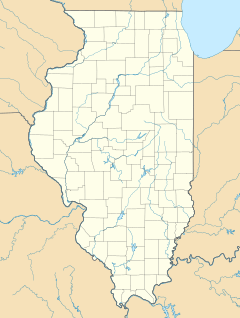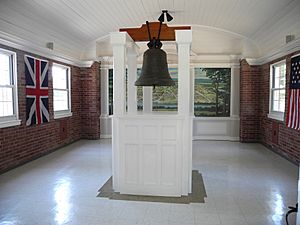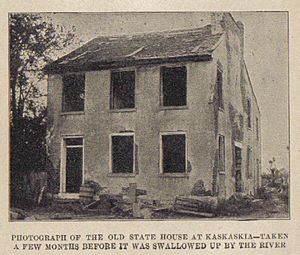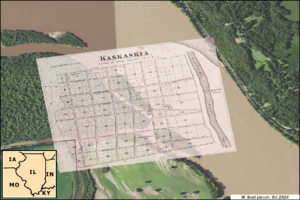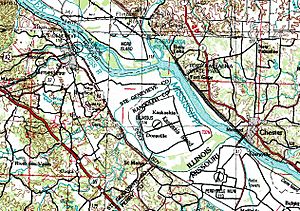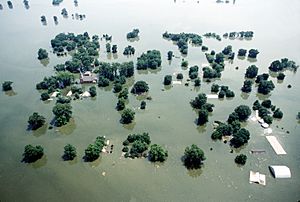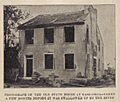Kaskaskia, Illinois facts for kids
Quick facts for kids
Kaskaskia
|
|
|---|---|

Kaskaskia Church
|
|

Location of Kaskaskia in Randolph County, Illinois
|
|
| Country | United States |
| State | Illinois |
| County | Randolph |
| Area | |
| • Total | 0.11 sq mi (0.27 km2) |
| • Land | 0.11 sq mi (0.27 km2) |
| • Water | 0.00 sq mi (0.00 km2) |
| Elevation | 374 ft (114 m) |
| Population
(2020)
|
|
| • Total | 21 |
| • Density | 198.11/sq mi (76.84/km2) |
| Time zone | UTC-6 (CST) |
| • Summer (DST) | UTC-5 |
| ZIP Code(s) |
63673
|
| Area code(s) | 618/366 |
| FIPS code | 17-39129 |
| GNIS feature ID | 2398330 |
Kaskaskia is a small village in Randolph County, Illinois. It has a long and interesting history. Native American tribes lived here for thousands of years. Later, French settlers arrived and named the village after the Kaskaskia people.
In the 1700s, Kaskaskia was a busy place with about 7,000 people. It was an important center for the region. During the American Revolutionary War, American soldiers took control of the town from the British. Kaskaskia even became the first capital of the Illinois Territory in 1809. When Illinois became a state in 1818, Kaskaskia was its first capital for a short time. The capital later moved to Vandalia.
A big flood in 1881 destroyed most of the town. The Mississippi River changed its path, moving eastward and covering the old town site. Today, Kaskaskia is on the west side of the river, but it's still part of Illinois. A small bridge crosses the old riverbed.
In 2020, only 21 people lived in Kaskaskia, making it one of the smallest villages in Illinois. It has an Illinois phone area code (618) but a Missouri ZIP Code (63673). The roads are kept up by Illinois, and its residents vote in Illinois elections. The town was flooded again in the Great Flood of 1993, with water more than 9 feet deep.
Contents
A Look Back: Kaskaskia's Past
Early Native American Life
The area where Kaskaskia is located was home to many Native American tribes for thousands of years. The Kaskaskia people, part of the Illiniwek group, settled here in the 1600s. They traded with early French colonists. The name "Kaskaskia" was spelled in many ways over time.
During the Beaver Wars, Kaskaskia grew as people gathered for protection against attacks. By the 1680s, about 20,000 people lived there. The Kaskaskia people worked with the French to defend themselves. The French also provided goods for trade. Kaskaskia became involved in trading, including trading people captured from other nations.
By the 1690s, Kaskaskia's population began to shrink. A disease outbreak hit the town hard. It also became harder to find wood and bison nearby. The Great Peace of Montreal in 1701 ended the Beaver Wars, which also reduced the need for people to live together for safety.
French Settlement and Growth
In 1703, French Jesuit missionaries came to Kaskaskia. They wanted to teach Native Americans about Catholicism. The first stone church was built in 1714. The French also set up a fur trading post. French-Canadian settlers moved in to farm and mine for lead across the river in what is now Missouri.
Kaskaskia was well-located on a piece of land by the Mississippi River. It became a major settlement, attracting many Native Americans. It was made the capital of Upper Louisiana. The French built Fort de Chartres nearby in 1718. That same year, they brought the first enslaved Africans from the Caribbean to work in the lead mines.
In its early years, Kaskaskia was a mix of cultures. There were French men and many Illinois and other American Indians. In 1707, about 2,200 people lived there, mostly Illinois people. A visitor in 1715 said the village had 400 Illinois men, two Jesuit missionaries, and about 20 French traders who had married Native American women. Most children born there before 1714 had Native American mothers and French fathers.
Many French-Canadians from Kaskaskia became explorers and traders. They traveled the Missouri River country to trade for furs. They wanted to trade with all the tribes of the plains and even with the Spanish in New Mexico. This led to expeditions, like the one by Claude Charles Du Tisne in 1719.
King Louis XV of France sent a bell to Kaskaskia in 1741 for its church. Kaskaskia and other French towns in the Illinois Country were very important. They supplied Lower Louisiana, especially New Orleans, with wheat and corn. These crops could not grow well in the warm Gulf climate. Farmers sent tons of flour south, helping New Orleans survive.
The French built Fort Kaskaskia around 1759. It was an earthen fort on a bluff overlooking the village. These types of forts were common for defense against Native American attacks.
In 1763, France lost the Seven Years' War (also called the French and Indian War). They gave the Illinois country, including Kaskaskia, to Great Britain. Many French-speaking people moved west of the Mississippi River to places like Ste. Genevieve and St. Louis. They did not want to live under British rule. Kaskaskia continued as a French-speaking village even after the British left Fort de Chartres in 1772.
American Control and Statehood
During the American Revolution, American soldiers led by George Rogers Clark captured Kaskaskia on July 4, 1778. The church bell was rung to celebrate this victory. It has been known as the "liberty bell" ever since. The brick church, built in 1843, was later moved to the rebuilt Kaskaskia village.
In 1803, the Kaskaskia people signed a treaty with the United States. This treaty was arranged by William Henry Harrison, who later became president. The Kaskaskia tribe gave up a large area of land, about half of modern-day Illinois. In return, they received 350 acres near Kaskaskia and the right to move to another larger settlement.
Kaskaskia became the capital of the Illinois Territory in 1809. It remained the capital until Illinois became a state in 1818. It was then the state capital for a short time until 1819. The first newspaper in Illinois, the Illinois Herald, was printed here in 1814. Kaskaskia also hosted Illinois's first meeting to write its constitution and its first legislative session.
The town's population was highest around 7,000 before the capital moved to Vandalia in 1819. The arrival of steamboats on the Mississippi River helped river towns grow. However, steamboats also caused problems. Crews cut down many trees along the riverbanks for fuel. This led to deforestation and erosion, causing the riverbanks to collapse into the water.
In 1832, the Peoria tribe, representing the Kaskaskia and other tribes, signed another treaty. This treaty was part of the Indian removal efforts. It meant that all tribal lands, except for 350 acres for one family, were given up. Most members of these tribes were moved to Indian Country in what is now Kansas.
The River's Impact on Kaskaskia
Over time, the Mississippi River became wider and shallower. This caused more severe floods. In the late 1800s, Kaskaskia was cut off from the Illinois mainland. It was mostly destroyed by floods and the river changing its path. Much of the old town site is now gone. After the Great Flood of 1844, people moved the town south. The original Kaskaskia became an island. The flood of 1881 destroyed what was left of the old town. The Mississippi River then started flowing through the Kaskaskia River's channel, passing east of the town instead of west.
Parts of the town were rebuilt in the new area. As the Mississippi continued to flow in its new path, land built up. This connected the village to the west bank of the river, which is mostly in Missouri. The old river channel is now a bayou that floods regularly. A small bridge connects Kaskaskia to the mainland. In 1893, the people moved and rebuilt the Church of the Immaculate Conception. They also built a shrine nearby to hold the "liberty bell."
By 1950, only 112 people lived in Kaskaskia. The population kept falling, reaching 33 in 1980. The town was covered by 9 feet of water during the Great Flood of 1993. By 2000, Kaskaskia had only nine residents. It was almost a ghost town and the least populated community in Illinois.
Kaskaskia's Location
Kaskaskia is located at 37°55′17″N 89°54′59″W / 37.921395°N 89.916467°W. The village itself is small, about 0.11 square miles (0.27 square kilometers) of land. However, it is part of a larger area called Kaskaskia Precinct. This precinct includes all of Randolph County's land west of the Mississippi River. Kaskaskia Precinct is about 24 square miles (62 square kilometers) and had 31 people in 2020. In 1993, the Mississippi River almost completely flooded the island.
Who Lives in Kaskaskia?
| Historical population | ||
|---|---|---|
| Year | Pop. | ±% |
| 1818 | 7,267 | — |
| 1900 | 177 | −97.6% |
| 1910 | 142 | −19.8% |
| 1920 | 152 | +7.0% |
| 1930 | 107 | −29.6% |
| 1940 | 131 | +22.4% |
| 1950 | 112 | −14.5% |
| 1960 | 97 | −13.4% |
| 1970 | 79 | −18.6% |
| 1980 | 33 | −58.2% |
| 1990 | 32 | −3.0% |
| 2000 | 9 | −71.9% |
| 2010 | 14 | +55.6% |
| 2020 | 21 | +50.0% |
| U.S. Decennial Census 2020 Source: |
||
In 2000, there were 9 people living in Kaskaskia, making up 4 households and 3 families. The population density was about 83 people per square mile. There were 5 houses. Most residents were White. There were also 1 Pacific Islander and 1 person of another race. Two people were of Hispanic or Latino background.
Of the four households, none had children under 18. Two were married couples. One household had a female head with no husband. One was a non-family household. One person lived alone who was 65 or older. The average household had 2.25 people.
In terms of age, two people were under 18 (both girls). There was one person aged 18 to 24, one from 25 to 44, two from 45 to 64, and three who were 65 or older. The average age was 48 years. There were seven females and two males.
Famous People from Kaskaskia
Many notable people have connections to Kaskaskia:
- David J. Baker (1792-1869), a United States senator.
- David J. Baker Jr. (1834-1899), who became Chief Justice of the Illinois Supreme Court.
- Shadrach Bond (1773-1832), the first Governor of Illinois from 1818-1822.
- John Duff, a soldier in the Revolutionary War and scout for George Rogers Clark.
- Thomas Duncan, a general during the American Civil War.
- John Edgar, a businessman and lawmaker.
- George Fisher, a pioneer, doctor, and lawmaker.
- William Gillis (businessman) (1788–1869), a businessman who helped found Kansas City, Missouri.
- John Rice Jones, a judge and politician.
- Samuel Judy, a pioneer and lawmaker.
- Lucien Maxwell, a famous rancher.
- John Willis Menard, the first African American elected to the United States Congress.
- James L. D. Morrison, an officer in the Mexican War and U.S. Representative.
- John Doyle Lee, a leader connected to the Mountain Meadows Massacre.
- Nance Legins-Costley (1813-1892), the first enslaved person freed by Abraham Lincoln in 1841.
- Thomas Jefferson Vance Owen (1801-1835), the first president of the Board of Trustees for the 'Town of Chicago'. He lived in Kaskaskia from age 8.
- Étienne de Boré (1741-1820), the first Mayor of New Orleans.
Images for kids
-
USGS topographic map of Kaskaskia
See also
 In Spanish: Kaskaskia para niños
In Spanish: Kaskaskia para niños


